FANTASTIC THURSDAY NIGHT, 21 JUNE
What a Moon:
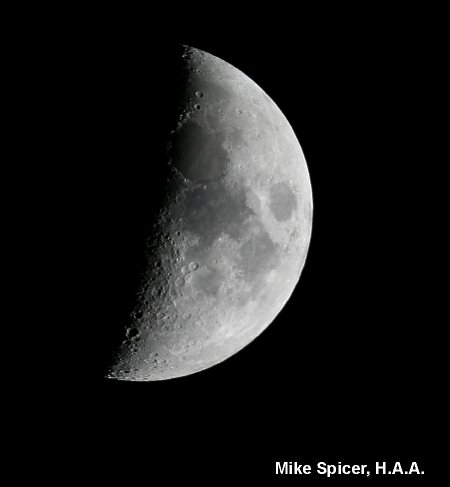
FANTASTIC THURSDAY NIGHT, 21 JUNE
What a Moon:

After carefully monitoring the weather conditions and checking Kerry’s reports, we decided to open up Binbrook. On the way up, I was getting worried when I saw the sky covered in high level clouds. Fortunately I needn’t fret as the clouds disappated for a clear night.
When I arrived, Jackie had just packed up her 80mm Nexstar after spending several hours of solar observing, and was in the process of setting up the 80mm apo for the night session.
Eventually John G showed up with his 5″ Dob, Kerry brought her 6″ Schmidt, Tim H had his 80mm apo on a table mount (wasn’t it a little cool sitting on the ground?). Jim W arrived with his 8″ Celestron and of course I had my 7″ Mak. Around 10:30 Steve G appeared with his 4″ loaner Newtonian and his parallelogram binocular mount. (Surprisingly no one set up any imaging equipment – it was going to be strictly an observing night.) We had a great variety of scopes set up and we had clear skies. On the shortest night of the year, we were going to make the best of it.
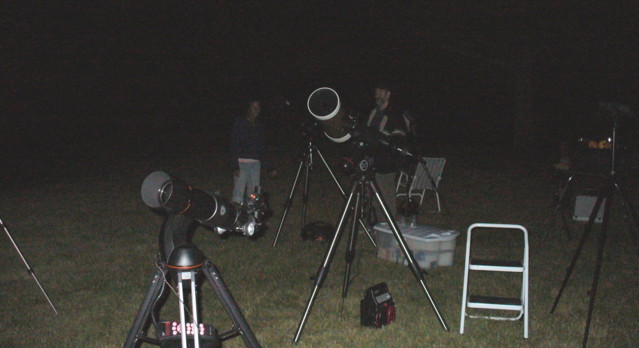
Early we had a great view of Venus, Saturn, Regulus and the waxing cresent moon all lined up in a row. We really enjoyed looking at the terminator on the moon, especially with the various binoviewers that were present. Between breaks in some mild unsettled air near the horizon, we could see many bands and colours on Jupiter and its 4 moons lined up equally on both sides of the planet. Coincidentally, there was a star of about equal magnitude in perfect alignment with the moons and it looked like Jupiter had gained a 5th Galilean moon.
John G had come prepared and notified us of the scheduled passing of the ISS and shuttle. Right on time they went by and we all had a chance to watch the two of them fly by, separated by about 35 degrees. While we couldn’t track with the scopes, we trained the binoculars we had on them. Regrettably we couldn’t make out much detail due to the low angle of their passing. But it was still a nice treat.
With all the equipment present, we spent a fair amount of time swapping pieces to see what we liked. Jackie had her Celestron binoviewer, I had my Antares and Kerry was trying out some Lomo’s she had borrowed. Everyone agreed that viewing with BV’s was a real joy. We trained them on the moon, globulars and nebulaes. The images were slightly less bright than with a single eyepiece, but the comfort of using 2 eyes and the increased perceived depth perception made up for the lack of brightness. After attempting to do a careful evaluation of trying each on different scopes and using the same eyepieces, I think the consensus was that the Celestrons and Antares were nearly identical. The surprise was the Lomo’s. Most felt they weren’t quite as bright or crisp as the other two. They were nice, but just not quite as appealing as the others. This was quite baffling since they have a very good reputation. Several hypotheses were debated, but we agreed we didn’t have enough knowledge to explain the difference.
In addition to trying out the various BV’s, we also swapped eyepieces around. Without exception, everyone agreed the best was John G’s Pentax WX EP’s. They were amazingly brighter and crisper than any of the stock eyepieces that most of us were using. Even on his 5″ Dob, M13 was as bright and clear (when we could get the scope to stay on the cluster) as on my 7″ Mak with a regular eyepiece. While great eyepieces, they were a little heavy for his small Dob. The rest of us were drooling and green with envy. (I think I know what I want for Christmas.)
Just as Kerry predicted, the clouds started to roll in around 1am so we decided to pack it in which was just as well. Since some of us had to work in the morning and if the good conditions had persisted, we might have stayed all night. A few of us stopped off at Tim’s afterwards for a nightcap.
It was an excellent night. We hit a lot of objects, each of us calling them out so others could come take a look. We had a lot of fun trying out equipment and enjoying each others company. What a great way to spend a summer evening with a bunch of active and enthusiastic HAA club members. Can’t wait to do it again. (How’s the weather this weekend Kerry?) And again our thanks to Binbrook Conservation Area for letting us make use of such a great location for our observing.
A LITTLE OBSERVING, A LITTLE IMAGING, JUNE 17-8
The predicted morning rain failed to develop, but the CSC prediction for the evening changed from blue to grey. Steve K and I shelved our plans to image at Binbrook. As evening fell the sky didn’t look too bad. I was shooting the crescent Moon below Venus when Steve dropped by (Monday night the Moon will be between Venus and Saturn):
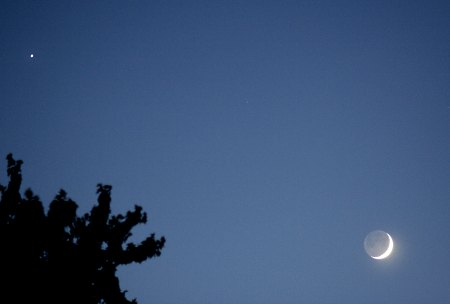
The air was heavy with moisture and the seeing was only 4 or 5 arc-seconds (components of Epsilon Lyrae scintillated badly and planetary nebulas didn’t show detail). We looked at a number of objects but decided to image Io’s transit of Jupiter starting about 1:30 am when the moon’s dark shadow, closely trailing the moon, was just on the planet’s limb:
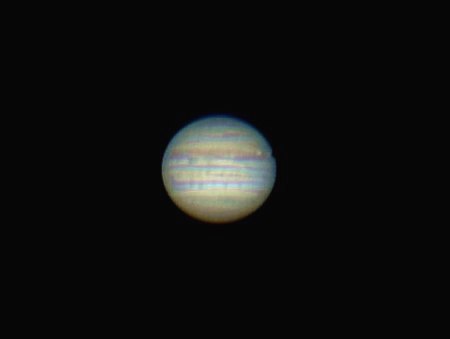
The seeing never really improved but by 1:45 am it was possible to see both Io (transiting against the NEB) and its shadow against the planet’s disk:
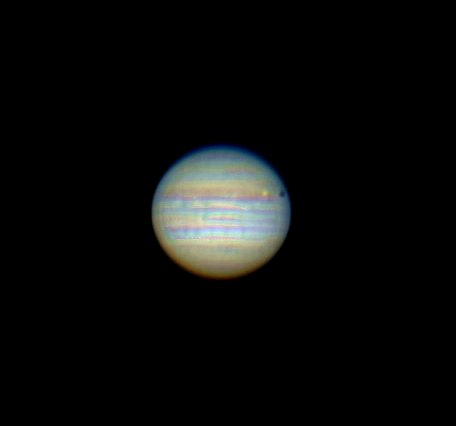
Monday night is looking better for observing and imaging. Steve K and I plan to go to Binbrook; email me if you are interested in joining us!
By: KerryLH
After checking the satellite and a few forecast profiles for YHM (hamilton airport) I figured that there would be a brief clear break in the late evening before the cloud from the approaching front arrives. Because I wasn’t expecting prolonged stargazing conditions I set my c6 up on the camera tripod (These kind of nights I wish I had a dob on wheels) for some quick viewing. The plan was to check out the binoviewers that Mike loaned me. After the initial set up I was a little disappointed because I couldn’t reach focus with them but then realized if I took the focal reducer off the C6 I might have better luck. Sure enough I did and spent a good hour touring the night sky with no star charts, no finder and two eyes. I managed to stumble across many open clusters… what beautiful sites. The stars weren’t as sharp as I was hoping but that could have been due to the shake from the tripod and the high upper winds. Overall though it was extremely comfortable and enjoyable to view with them. On my next clear night I will have to do further testing but on my steady cg5 mount.
Side note: I couldn’t believe that I completely ran into M57 by just scanning the sky… unfortunately the binoviewers weren’t on at the time. Anyway that’s it for me….
The next several days offer excellent chances to view passes of the International Space Station. It should be particularly bright since the Space Shuttle is currently docked with it.
For a schedule, go to the Heavens Above website at:
http://www.heavens-above.com
The last time Gail and I saw the ISS, the Shuttle had just undocked and we could see them both racing across the sky together – well worth the effort to catch!
SOME LOVELY LITTLE FLOWERS
Even using a large-format Digital Rebel imaging chip on the Nexstar 11, one could still obtain some pretty little images of planetary nebulas through the very still air over Hamilton on Tuesday night, here is an example, even after reduction to 450 pixcels wide in jpg format for posting here, do you recognize it as the Cat’s Eye nebula NGC 6543?:
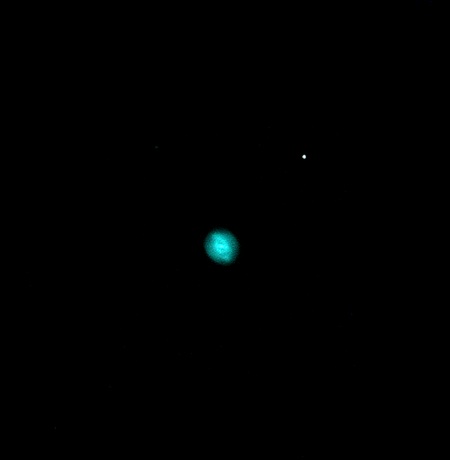
Here’s an old favourite in a 30 second image, same scope and camera:
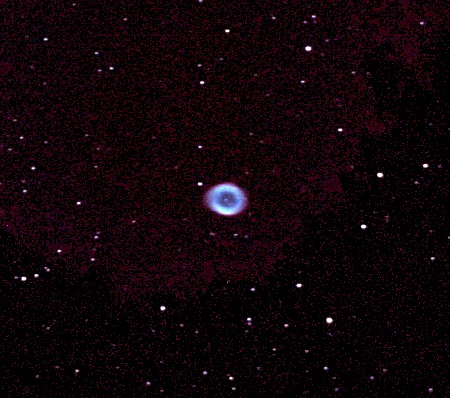
Finally, here’s a pretty number, recognize it as NGC 6210 in Hercules?
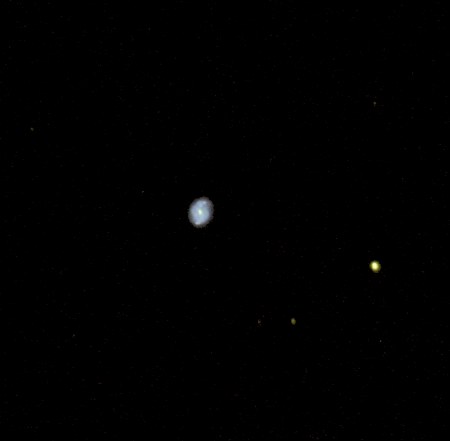
I got two excellent nights and one very good night in a row (last night was still very clear, but there was a slight twinkle to the stars). I tried my hand at imaging the North American Nebula – this one is very faint – I took three 20 minutes exposures as wisps of the nebulae could just barely be made out in the five minute test exposure. Even at 20 minutes I had to adjust the raw image exposure by +1 which made them all that much more grainy. Unfortunately though there was a problem with the tracking – I thought I had tracked all three exposures ok but afterward discovered I hadn’t firmly locked down the guide scope so I still wound up with star trailing. Anyhow, here is a first attempt 3 x 20 minute exposure of the North American Nebula drastically reduced:
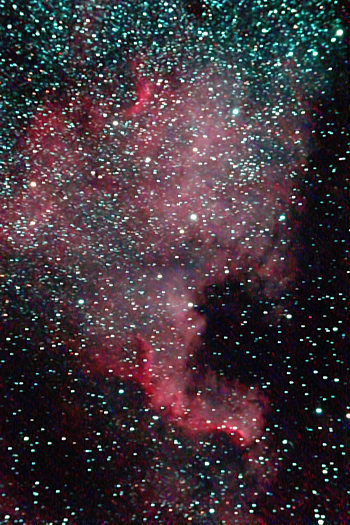
Also, the re-attempt at the Lagoon & Trifid resulted in much sharper detail which really shows on the lager image in my gallery (I did lock down the guide scope for this one) – this is 1 x 5, 2 x 10, and 1 x 15. I didn’t get a chance to post it yesterday as the phones (and DSL) went down:
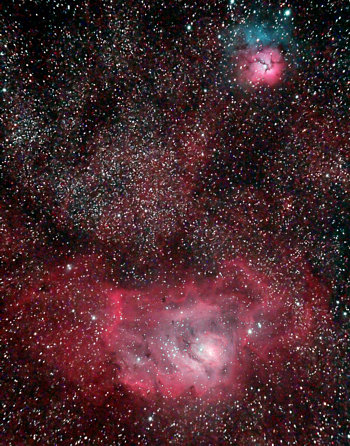
Looks like it was a good weekend of observing for all.
So Far, Three Beautiful Nights in a Row
Another all-nighter. Beautiful images of many deep sky objects, and at the end, a slim crescent Moon rose over the city just two hours before the sun. Hanging low in the slow-moving clouds that hug the horizon, the ashen light was visible in a small telescope. Here is a much reduced image:
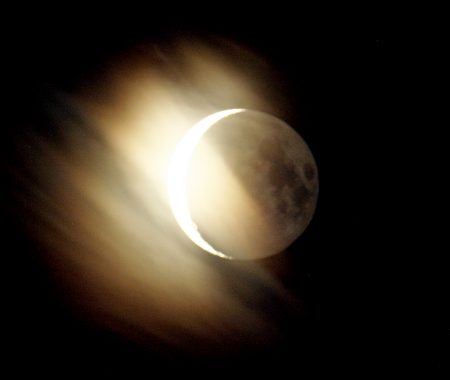
Sunday night unfortunately I did not meet up with the group in Binbrook. With the 9pm gate opening, I was thinking that I would not have enough time to set up for imaging before it got dark.
Anyway it worked out great in the end. I really enjoyed the comforts of observing and imaging from home and the bonus was that the sky was absolutely crystal clear and fairly dark (mag 5.5). I started out by observing my usual favourites. M51 and M101… what a huge difference in view compared to Thursday night. I could cleary make out the two bright cores and the fuzzy spiral arms of M51. M101 was much easier to see without averted vision. Afterwards I spent the rest of the night imaging targets like NGC4565, M57 and NGC6871. By the time I was ready to pack up it was late enough that I could catch a glimpse of the beautiful summer milky way.
My Sunday night setup
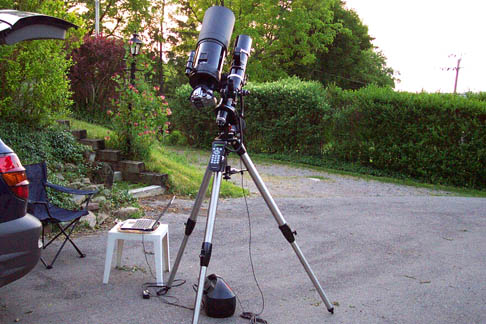
NGC4565 – I love observing this edge on galaxy. (NGC4562 is the faint smudge below)
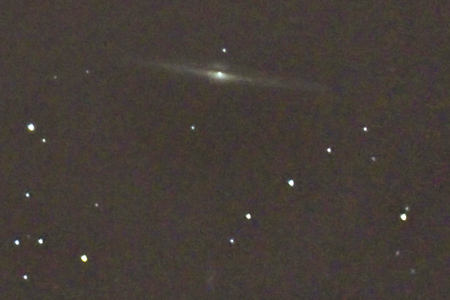
M57 – I had to try this target again. I wanted to get a sharper focus so that I could capture the 15th magnitude central star
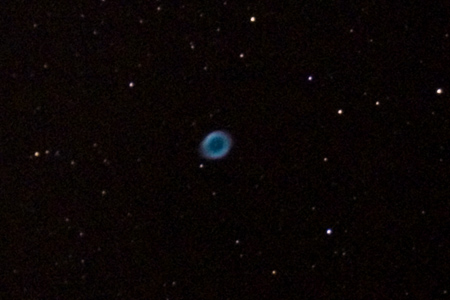
NGC6871 – an interesting looking open cluster in Cygnus.
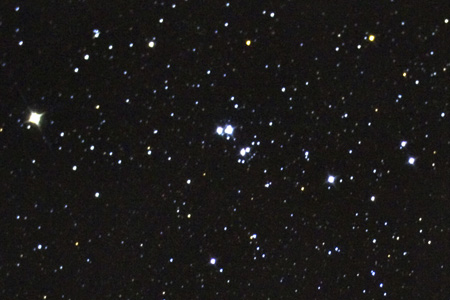
Realizations after the long night:
-An LPR filter needs to be on my ‘must buy list’
-imaging with the 80mm APO and using the 6in as a guidescope might help with getting
better quality longer exposure images
-It might be a better idea to concentrate on imaging only one target per night
-Imaging is more challenging than I ever imagined.. gathering the light frames
is only half the battle, post processing is the other half.
Observing report, June 10, 2007
5 of us arrived at Binbrook a bit before about 9pm. The gate was still open so i went in.
A ranger followed me about 10 minutes later and i explained i was with the astronomy club.
Some people came by on foot with their dogs, and then continued on their walk. I had arrived first and set up down at the beach but everyone else thought the top of the hill was much better. Not one to reject experience, i carried my scope and binoculars up the hill and moved the car.
My first project was the alignment of my finder scope. I used the distant trees, but it turned out that the trees are fractal in nature and i actually had aligned my finderscope with a different bunch of leaves that looked like mickey mouse.
Once i established that venus was nowhere to be seen in the scope, i repeated it with a more distinctive bunch of branches and had it perfectly aligned. It made a big difference since i could now use a high power eyepiece and verify with the finderscope that all was well.
First there was a fine sunset, with pastel hues of pink and purple. Venus and Saturn were out in the twilight, and we were able to bring them into view, and even see titan, long before the constellations were out. Before long we also spotted Jupiter from behind some trees near the horizon. John pointed out to us that we could now see 4 planets, almost half the solar system. I fell for that one and asked which was the fourth planet. “You’re standing on it”.
The space station was due to cross the sky at about 10:36 pm. In spite of some low
clouds we were able to pick it up with unaided eyes, and also find it in binoculars,
although it occurs to me that an orbital mount angle might be a handy way to track it
without all kinds of hand adjustment. John had printed out a chart of several expected satellites with timing and path predictions.
We saw several other satellites, but could not follow them all the way across the sky. They seemed to be bright for a few seconds and then dim down almost to invisibility in the skyglow over Hamilton.
We went over to the water’s edge and watched Venus reflected in the water. A fine meteor
shot past Venus and 2 of us saw it. Back up the hill after that.
We then toured the sky for globular and open clusters, M53, M57. Exchanging views in various scopes and binoculars.
I used my star charts and the EH to locate Vesta, first in binoculars, next in the spotting scope of my newtonian and finally in the scope itself. Star charts in the binoculars showed it to be a third ‘star’ near 2 charted stars of similar brightness.
The transit of Io across Jupiter was due to begin at 11:40 PM. We watched as it became not more than a bump on Jupiter, and then eventually we were able to see the shadow on Jupiter,
as a small black dot.
It was a nice evening, but there was almost no wind. In spite of that, we got no problems from dew except for Jackie’s scope which got packed up around midnight. She remained to look through John’s 80 mm refractor.

I tried to locate M4 in my scope. Although i could pick it up in the binoculars, it was much harder to find in the finderscope. Eventually i found it.
The 4.5 inch Newtonian served me well, again, but had some problems too… for one thing, there was not a very rich star field along with Vesta. I am spoiled by my binoculars.
So with the widest eyepiece, all i really had in the eyepiece was Vesta. The lack of a RA motor for it is one inconvenience, and the other is that there’s a lot of backlash and play in the motors, such that nudging the scope or turning the focuser will reposition it.
Also the focuser mechanism is not silky smooth, and this makes it harder to adjust the focus for planets.
John tried Jackie’s bino-viewer on his Orion 80, and the star fields were nice and dark
and sharp. John was positively delighted with the improvement in comfort, detail and ease of use with the bino-viewer. An additional bonus is that when you refer to the orientation of objects in the field of view, clock hours can make sense, since all observers will be in the same orientation. This is not the case with a single eyepiece.
John then attached a 2 inch diagonal and one of his wide field eyepieces. We looked at several nebulae including M16 and M17. John demonstrated that with a 2 inch diagonal, they could both be seen in the same field of view. This is possible on a shorted refractor but not with a SCT.
We returned to the Jupiter transit several times, while in the meantime seeking out Messier
objects against the rich background of the milky way in Saggitarius.
Compared to wintertime, it was balmy. I did not even have to do up my jacket, although
some people were a bit colder. A few hand warmers helped immensely. The weather was perfect, and the seeing was steady, the wind was not buffeting us or the scopes, and we remained there till after 2 am, then packed up and headed for home.
Once again it was worth the drive to Binbrook.
Clear skies!